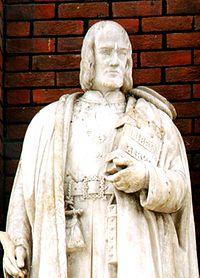John Carpenter (town clerk)
| John Carpenter, the younger | |
|---|---|

Statue of John Carpenter (1372-1442) which stands in a prominent position on a plinth high up on the wall of the City of London School's glassed ceiling atrium standing over the door to the balcony of the Great Hall. In this position 'He' also 'sees' the full splendour of St. Paul's Cathedral Dome.
|
|
| Born | abt 1372 & bapt. 18 Dec 1378 unknown & bapt. Hereford Cathedral, Hereford, England |
| Died | between 8 March 1441 (will) & 12 May 1442 (will proved) - maybe April 1442 buried in the Abbey of St. Peter, Westminster, Middlesex, England. |
| Nationality | English |
| Other names | John Carpenter, town clerk of London |
| Occupation | Town Clerk of London, author, founder |
| Known for | Liber Albus, City of London School, Member of Parliament from London |
John Carpenter, the younger (about 1372 – 1442), was a Town Clerk of London. He was elected as Town Clerk to the City of London during the reigns of Henry V and Henry VI. He was the author of the first book of English common law, called Liber Albus (the White Book). He was a member of the English Parliament from London in 1425. He is also recognized as the founder of the City of London School for boys. He resided in the Parish of St. Peter, Cornhill, London, and was buried in the Abbey of St. Peter, Westminster, where his wife Katherine was later interred.
He is frequently distinguished in historical documents as "John Carpenter, the younger," "John Carpenter, Junior [incorrectly]," and as "John Carpenter, Jenkin." Jenkin or Jenken is a diminutive of the name John.
John Carpenter was one of three men by that name who were prominent during the 15th century. Both others are mentioned in his will of 1442. One was his brother, John Carpenter the elder, who received much property from his younger brother.
John Carpenter may have been related in some way to the other John Carpenter who was the Warden of St. Anthony's Hospital, Rector of St. Mary Magdalen's, and finally Bishop of Worcester. Bishop John Carpenter was willed, by the subject of this article, "that book on architecture which Master William Cleve gave me." Cleve was King's Chaplain and clerk of the works, and carried out building at the Palace of Westminster and the Tower.
Thomas Brewer in his 1856 book on John Carpenter found no significant record of his life until his election as the Town Clerk or Common Clerk of the City of London on April 20, 1417, at about age 45. The exemption mentioned on page 14 suggests that John Carpenter had been in the City of London's service "from the time of his youth." It is assumed that he was apprenticed to John Marchaunt, his predecessor as Town Clerk. Based on Liber Albus (see below) and other works, he was familiar with the law.
Genealogical efforts have revealed a baptismal date of 18 Dec 1378 Hereford Cathedral, Hereford, England, but he was probably born earlier, with about 1372 being generally accepted. His father is listed as Richard Carpenter and his mother as Christina.
...
Wikipedia
